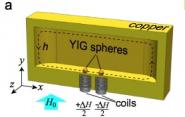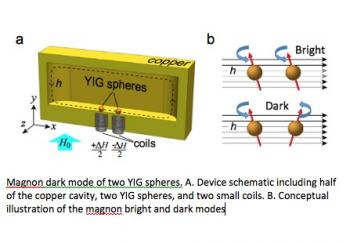Bringing More Memory To Quantum Communication

Quantum technology holds a great deal of promise, since it can potentially solve problems much faster or transfer information more secure than current technologies. But a number of obstacles stand in the way of it being used in a practical way. One problem is that the quantum bits of information (or qubits) are lost so quickly. Finding a way to store and retrieve these qubits in solid state memories would go a long way toward making practical use of this technology.
To that end, a group of researchers from Yale and the University of Erlangen-Nuremberg Staudtstr have developed a promising approach for developing longer-lasting quantum memories. In a study published last year, the same researchers developed a hybrid system that strongly couples magnons—the smallest unit of measurement for a magnetic spin excitation—with microwave photons.
 In their more recent study, posted online Monday in Nature Communications, they have built on this breakthrough by developing what's known as a magnon gradient memory.
In their more recent study, posted online Monday in Nature Communications, they have built on this breakthrough by developing what's known as a magnon gradient memory.
"In our previous study, we realized the strong coupling between the magnon and the microwave photon," said the paper's lead author, Xufeng Zhang, a Ph.D. student in Prof. Hong Tang's lab in Electrical Engineering. "We demonstrated that the information could transfer between the two systems multiple times before it decayed. In this system, we looked at coupling to store information from microwave to magnon."
This system uses a series of spheres of yttrium iron garnet (YIG), which is a low-loss medium for magnon, in a 3-dimensional (3D) microwave cavity. Each YIG sphere is applied with a slightly different magnetic field, so the magnon in the spheres resonate at slightly different frequencies - but all at approximately the resonance frequency of the 3D microwave cavity. The superposition of these magnon modes leads to a "bright mode," which is accessable by the microwave cavity, and a series of "dark modes," which is isolated from the outside world.
"The frequency gradient leads to the temporal evolution of the magnon between the dark modes and the bright mode," said Chang-Ling Zou, the paper's co-first author and a postdoctoral fellow jointly in Prof. Hong Tang's and Prof. Liang Jiang's group. "As a result, information can couple to the bright mode and stay as the dark modes for a period of time before it evolves back to the bright mode and gets retrieved."
Co-author Liang Jiang, assistant professor of applied physics, noted that because they are decoupled from their environment, dark modes prevent the decay of information, and thus extend their lifetimes. That allows for the storage of information.
And because YIG has such a high density of spin, the coupling between magnon and microwave photon is significantly enhanced, which in turn facilitates the information storage and retrieval process and results in very high efficiency, said Tang, who is the corresponding author of the paper.
The paper's other authors are Na Zhu, Ph.D. student in Prof. Hong Tang's lab, and Florian Marquardt, professor of physics in the University of Erlangen-Nuremberg Staudtstr.

